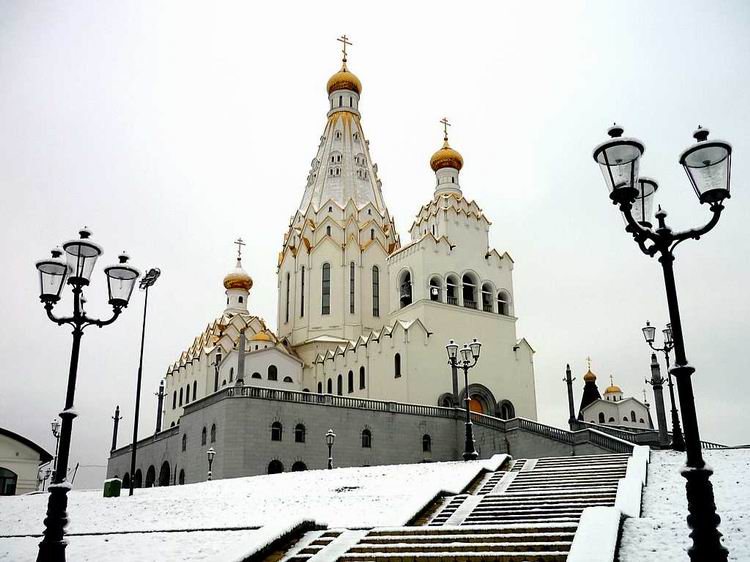|
Vatican Radio's Belarusian Service
Vatican Radio's Belarusian Service is a structural department of the Vatican Radio broadcasting network in the Belarusian language. History Fr. Piotr Tatarynovich (1950-1970) Vatican Radio started regular broadcasting in the Belarusian language on January 6, 1950. Before that, on December 24, 1949, it transmitted Pope Pius XII's message at Christmas and at the beginning of the Jubilee year in Belarusian. Roman Catholic priest Piotr Tatarynovich was the first editor-in-chief and for a long time the only staff member of the Belarusian Service. Originally the programs were broadcast on a weekly basis and contained news from the Vatican, information on the Catholic church and the Belarusian diaspora, as well as catechesal and apologetic reflections. Later Fr. Kastus Maskalik joined the Service working mainly as an announcer. Bishop Ceslau Sipovich, Fr. Tamash Padzyava and some other Belarusian Catholic immigrants collaborated with the Service. After his retirement in 1970 Fr. T ... [...More Info...] [...Related Items...] OR: [Wikipedia] [Google] [Baidu] |
Vatican Radio
Vatican Radio (; ) is the official broadcasting service of Vatican City. Established in 1931 by Guglielmo Marconi, today its programs are offered in 47 languages, and are sent out on short wave, DRM, medium wave, FM, satellite and the Internet. Since its inception, Vatican Radio has been maintained by the Jesuit Order. Vatican Radio preserved its independence during the rise of Fascist Italy and Nazi Germany. Today, programming is produced by over 200 journalists located in 61 countries. Vatican Radio produces more than 42,000 hours of simultaneous broadcasting covering international news, religious celebrations, in-depth programs, and music. The current general director is Father Federico Lombardi, S.J. On 27 June 2015, Pope Francis, in a ''motu proprio'' apostolic letter, established the Secretariat for Communications in the Roman Curia, which absorbed Vatican Radio effective 1 January 2017, ending the organization's 85 years of independent operation. History 1930s Vat ... [...More Info...] [...Related Items...] OR: [Wikipedia] [Google] [Baidu] |
Belarusian Language
Belarusian (, ) is an East Slavic languages, East Slavic language. It is one of the two Languages of Belarus, official languages in Belarus, the other being Russian language, Russian. It is also spoken in parts of Russia, Lithuania, Latvia, Poland, Ukraine, and the United States by the Belarusian diaspora. Before Belarus Dissolution of the Soviet Union, gained independence in 1991, the language was known in English language, English as ''Byelorussian'' or ''Belorussian'', or alternatively as ''White Russian''. Following independence, it became known as ''Belarusian'', or alternatively as ''Belarusan''. As one of the East Slavic languages, Belarusian shares many grammatical and lexical features with other members of the group. To some extent, Russian, Ukrainian language, Ukrainian, and Belarusian retain a degree of mutual intelligibility. Belarusian descends from a language generally referred to as Ruthenian language, Ruthenian (13th to 18th centuries), which had, in turn, descend ... [...More Info...] [...Related Items...] OR: [Wikipedia] [Google] [Baidu] |
Pope Pius XII
Pope Pius XII (; born Eugenio Maria Giuseppe Giovanni Pacelli; 2 March 18769 October 1958) was the head of the Catholic Church and sovereign of the Vatican City State from 2 March 1939 until his death on 9 October 1958. He is the most recent pope to take the Papal name, pontifical name "Pius". The papacy of Pius XII was long, even by modern standards; it lasted almost 20 years, and spanned a consequential fifth of the 20th century. Pius was a diplomat pope during the destruction wrought by the Second World War, Aftermath of World War II, the recovery and rebuilding which followed, the beginning of the Cold War, and the early building of a new International order, international geopolitical order, which aimed to protect human rights and maintain global peace through the establishment of international rules and institutions (such as the United Nations). Born, raised, educated, ordained, and resident for most of his life in Rome, his work in the Roman Curia—as a priest, then Bi ... [...More Info...] [...Related Items...] OR: [Wikipedia] [Google] [Baidu] |
Christianity In Belarus
Christianity is the main religion in Belarus, with Eastern Orthodoxy being the largest denomination. The legacy of the state atheism of the Soviet era is apparent in the fact that a proportion of Belarusians (especially in the east part of the country) are not religious. Moreover, other non-traditional and new religions have sprung up in the country after the end of the Soviet Union. According to the estimations for 2011 by the Ministry of the Interior, 73.3% of the Belarusians are Orthodox Christians, 14.8% are irreligious (atheists and agnostics), 9.7% are Catholics (either Latin Catholic and Belarusian Greek Catholic), and 3.5% are members of other religions (mostly Pentecostals). History By the end of the 12th century, Europe was generally divided into two large areas: Western Europe with dominance of Catholicism, and Eastern Europe with Orthodox and Byzantine influences. The border between them was roughly marked by the Bug River. This placed the area now known as Belar ... [...More Info...] [...Related Items...] OR: [Wikipedia] [Google] [Baidu] |
Adam Maldzis
Adam Maldzis (, 7 August 1932 – 3 January 2022) was a Belarusian historian, literary critic, author and journalist. He was described as "a patriarch of Belarusian humanities", "an excellent connoisseur of literature" and "a living bridge between Belarus and the scholars of Belarusian studies around the world". He was “the author of unique studies of the ”. Life and career Maldzis was born in the village of Rasoly, Oszmiany District, Poland (now in Astraviec District of Belarus) – a place on a cross-road of "different influences – national, religious and cultural". At school he began publishing articles in children's periodicals. He earned a degree in journalism from the Belarusian State University followed by postgraduate studies at the Yanka Kupala Institute of Literature of the Belarusian Academy of Sciences. In 1962–1991, Maldzis worked at the Institute of Literature of the Academy of Sciences of Belarus. His main academic interest and specialism was in Bela ... [...More Info...] [...Related Items...] OR: [Wikipedia] [Google] [Baidu] |
Janka Zaprudnik
Jan Zaprudnik (9 August 1926 – 26 May 2022, born Siarhej Vilčycki) was a Belarusian-American historian and publicist. He was also one of the leaders of the Belarusian community in the United States and an honoured member of the Belarusian PEN-centre. Biography Jan Zaprudnik was born into a family of school teachers in what was then the Second Polish Republic. During the Occupation of Belarus by Nazi Germany, Zaprudnik graduated from the Gymnasium in Baranavičy and studied at a high school there. In 1944, Jan Zaprudnik fled to Germany because of his likely persecution for collaboration with invaders by Soviet authorities.''Запруднік Янка''. ("Zaprudnik, Janka"). Aradžency Biełarusi. 2008. Retrieved 6 August 2009. [...More Info...] [...Related Items...] OR: [Wikipedia] [Google] [Baidu] |
Radio In Vatican City
Radio is the technology of telecommunication, communicating using radio waves. Radio waves are electromagnetic waves of frequency between 3 hertz (Hz) and 300 gigahertz (GHz). They are generated by an electronic device called a transmitter connected to an antenna (radio), antenna which radiates the waves. They can be received by other antennas connected to a radio receiver; this is the fundamental principle of radio communication. In addition to communication, radio is used for radar, radio navigation, radio control, remote control, remote sensing, and other applications. In radio communication, used in radio and television broadcasting, cell phones, two-way radios, wireless networking, and satellite communication, among numerous other uses, radio waves are used to carry information across space from a transmitter to a receiver, by Modulation, modulating the radio signal (impressing an information signal on the radio wave by varying some aspect of the wave) in the tran ... [...More Info...] [...Related Items...] OR: [Wikipedia] [Google] [Baidu] |
Radio In Belarus
This is a list of FM and OIRT FM Band radio stations based in Belarus. By law, FM radio stations have to rotate music made in Belarus 75% of broadcasting time. Mostly FM stations broadcast in Russian. National State Radio The National State Television and Radio Company of the Republic of Belarus is the state television and radio broadcasting service in Belarus. * First Channel (FM and UKV) * Channel "Culture" (FM and UKV) * Radius-FM (FM in Belarus and 72,11 UKV in Minsk) * Radio "Stolitsa" (FM and UKV) Regional stations: * Radio Brest (FM and UKV) * Radio Vitebsk (FM and UKV) * Gomel FM (FM and UKV) * Radio Grodno (FM and UKV) * Radio Mogilev (FM and UKV) Local stations: * Homiel plus (Homiel - 103.7 FM) * Gorod FM (Brest - 97.7 FM) International station: * Radio Station "Belarus" (Internet, satellite and FM (Brest - 106.2 FM, Svislach - 104.4 FM, Hrodna - 95.7 FM, Heraneny - 99.0 FM, Miadel - 102.0 FM, Braslau - 106.6 FM)) Other state radio stations ''Note: ... [...More Info...] [...Related Items...] OR: [Wikipedia] [Google] [Baidu] |






